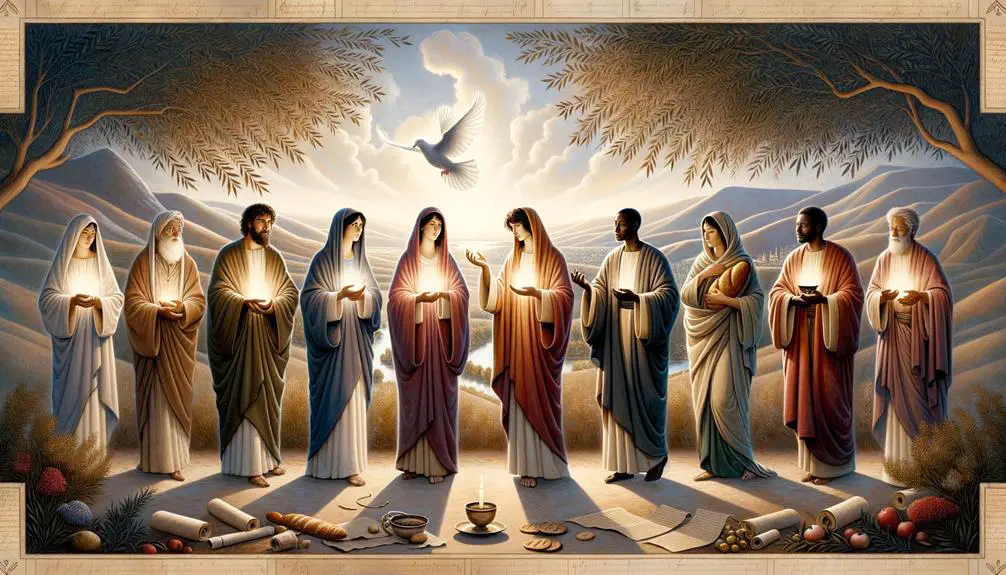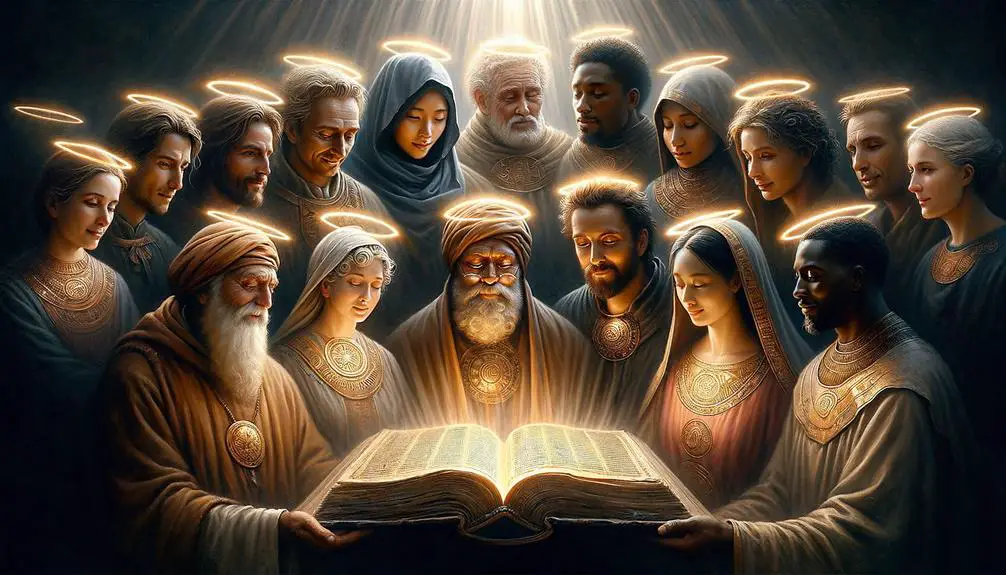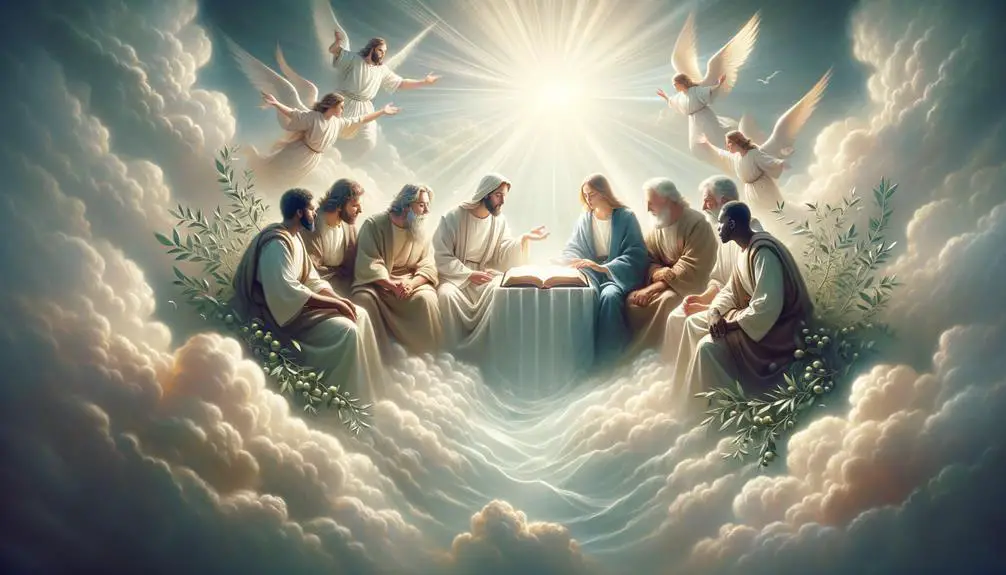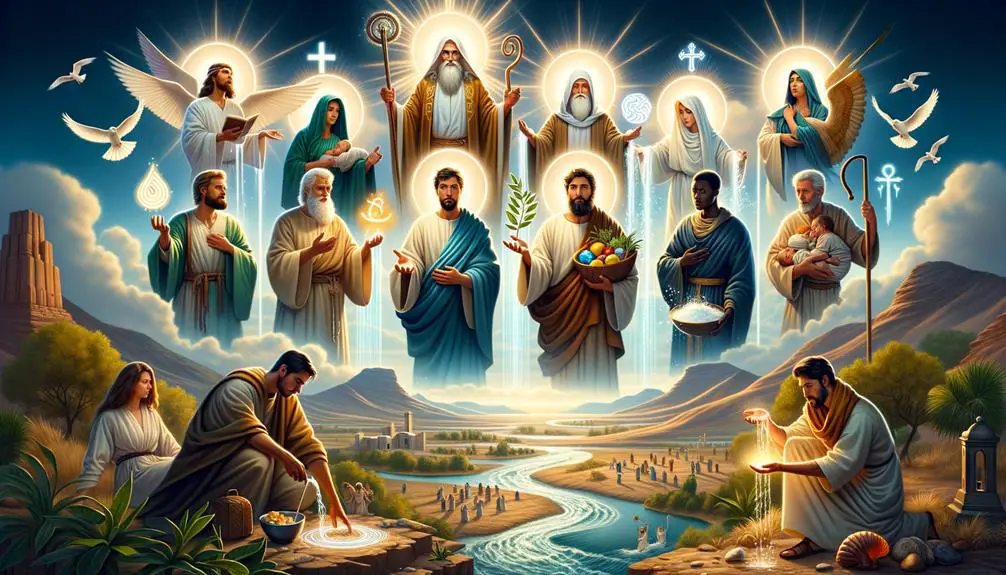Saints in the Bible span from devout believers to canonized figures, shaping faith's journey through history—discover their transformative role.

Who Are Saints in the Bible
Navigating the concept of saints in the Bible is akin to embarking on a journey through a rich tapestry of faith and history. You'll find that the term 'saint' evolves from the Old to the New Testament, reflecting shifts in understanding and context.
In the Old Testament, it's a designation for the devout, while the New Testament broadens this to include all believers, highlighting a communal aspect of holiness. The process of canonization, which isn't biblically outlined but developed over centuries, adds layers to their significance.
Unraveling who saints are and their impact on modern faith invites you to explore the intersections of divinity, humanity, and the miraculous, promising insights into how these figures continue to shape spiritual landscapes.
Key Takeaways
- Saints in the Bible exemplify faith, devotion, and righteousness, serving as models for believers.
- Their stories highlight the transformative power of God's grace and living in accordance with His will.
- Biblical saints act as moral guides, offering timeless lessons on navigating contemporary morality.
- They inspire believers to emulate their virtues in spiritual journeys, influencing ethical decisions and shaping moral compasses.
Defining Biblical Saints

In the context of the Bible, saints are defined as individuals sanctified by God, set apart for His divine purposes. This definition is rooted deeply in the historical context of the scriptures, providing a foundation for understanding the characteristics and roles of these individuals across both the New and Old Testaments. When you delve into the analysis of saintly attributes within biblical narratives, it's clear that these aren't merely honorary titles but are indicative of a profound relationship with the divine.
Saintly attributes, as detailed in the scriptures, encompass a wide range of virtues and roles. These individuals are often depicted as exemplars of faith, piety, and devotion to God's will. Their lives serve as models for believers, illustrating the path of righteousness and divine service. The historical context of these narratives further illuminates the significance of saints in the biblical era. In times of turmoil, persecution, and moral ambiguity, saints stood as beacons of hope and guidance for the faithful.
Moreover, the concept of sanctification—being set apart for God's purpose—entails a transformative process. This transformation isn't merely moral but encompasses a total dedication to the service of God and humanity. Through this lens, the definition of saints expands beyond the bounds of personal piety to include a communal and societal dimension. Saints, therefore, aren't just individual heroes of faith but are integral to the fabric of the biblical message, embodying the ideals of love, service, and sacrifice.
Analyzing the biblical concept of saints through the prism of saintly attributes and historical context offers a nuanced understanding of their role and significance within the sacred texts.
Saints in the Old Testament
Numerous figures throughout the Old Testament are recognized as saints, embodying divine principles and leading lives dedicated to God's service. These individuals, often heralded for their unwavering faith and moral fortitude, played pivotal roles in the narrative of salvation history. By examining their lives, you gain insights into the characteristics that define a saint in the Old Testament context.
- Noah: Among the earliest of righteous figures, Noah stands out for his obedience. His decision to build the ark, adhering to God's command amidst widespread wickedness, underscores a life of faith and complete trust in divine will.
- Abraham: Referred to as the 'Father of Faith,' Abraham's journey exemplifies the essence of righteousness. His willingness to sacrifice his son Isaac, though ultimately prevented by God, illustrates profound faith and obedience, hallmarks of sainthood in the biblical sense.
- Moses: As a leader and lawgiver, Moses embodies prophetic roles, acting as God's messenger to deliver the Israelites from Egyptian bondage. His life is a testament to the power of divine guidance and the importance of steadfast faith in the face of adversity.
- Elijah: The prophet Elijah's confrontations with the prophets of Baal showcase the struggle between true worship and idolatry. His zeal for the Lord and role in defending the faith against corruption highlight the prophetic mission of calling people back to righteousness.
These Old Testament saints, through their lives and actions, exemplify the qualities of devotion, obedience, and faith. They weren't only righteous figures but also held significant prophetic roles, serving as intermediaries between God and His people. Their legacies continue to inspire and instruct those seeking to live a life aligned with divine principles.
Saints in the New Testament

As you transition from the Old to the New Testament, you encounter a nuanced evolution in the concept of sainthood.
The New Testament introduces specific individuals and groups who are identified as saints, highlighting their roles and purposes within the early Christian communities.
This crucial shift not only reflects the changing religious landscape but also underscores the saints' pivotal contributions to the spread and consolidation of Christianity.
Identifying New Testament Saints
Delving into the New Testament, you'll find it replete with references to saints, individuals sanctified for their faith and dedication to the teachings of Jesus Christ. These saints are often highlighted through:
- Apostolic mentions, where apostles like Paul directly address or refer to individuals or groups as saints, recognizing their holy status within the early Christian community.
- Demonstrations of saintly virtues, including faith, love, and perseverance under persecution, which serve as markers of their sanctification.
- Participation in the early church's mission, contributing to the spread of the Gospel through various means.
- Personal transformations that align with Christ's teachings, showcasing a life changed and dedicated to God's service.
Through these indicators, the New Testament delineates the characteristics and behaviors that define a saint, offering a blueprint for sanctity.
Saints' Role and Purpose
Building on the identification of New Testament saints, it's crucial to explore the specific roles and purposes these figures played within the early Christian community. Saints were not merely historical or spiritual icons; they embodied saintly attributes that directly influenced their communities through divine communication and exemplary living. These individuals were conduits for divine messages, often interpreting divine will and guiding the faithful towards a deeper understanding of their faith.
Saintly Role |
Purpose |
Impact on Community |
|---|---|---|
Intercessors |
Mediating between God and man |
Strengthened faith |
Exemplars of Virtue |
Demonstrating saintly life |
Inspired moral living |
Teachers |
Spreading Gospel truths |
Deepened theological understanding |
Miracle Workers |
Showcasing divine power |
Reinforced belief in divine |
This table underscores their multifaceted roles, highlighting how their lives and actions served to foster a robust and dynamic Christian community.
The Process of Canonization
Understanding the process of canonization reveals how certain figures in Christianity were officially recognized as saints by the Church. This intricate process, deeply rooted in papal authority and historical contexts, underscores the Church's cautious approach to sainthood. It's a journey that involves several critical steps, each designed to ensure that only those truly worthy of the honor are canonized.
Here's a closer look at the key stages:
- Servant of God: The process begins when a bishop investigates a candidate's life and virtues after their death. If deemed virtuous enough, the Vatican grants the title 'Servant of God.'
- Venerable: After the Congregation for the Causes of Saints analyzes the candidate's life further, if found heroic in virtue, the Pope may declare them 'Venerable.'
- Blessed: For beatification, a miracle attributed to the candidate's intercession is required. Once verified, the Pope may beatify the individual, granting them the title 'Blessed.'
- Saint: Finally, a second miracle attributed to the Blessed's intercession, occurring after the beatification, must be recognized. Upon confirmation, the Pope can canonize the individual, officially recognizing them as a saint.
Throughout this process, papal authority plays a crucial role, with each step contingent upon the Pope's approval. The historical contexts surrounding the candidate's life and the miracles attributed to them are meticulously examined, reflecting the Church's commitment to preserving the sanctity of sainthood. This thorough and deliberate process ensures that the individuals canonized as saints truly exemplify Christian virtues and the power of faith.
Saints' Roles and Miracles

Having explored the rigorous process of canonization, we now turn our attention to the profound roles and miraculous deeds that have distinguished saints throughout Christian history. Saints have often served as intermediaries between the divine and the human, embodying moral and spiritual ideals that guide believers in their faith journeys. Their roles extend beyond mere historical or theological figures; they act as patrons, protectors, and exemplars of Christian virtues.
The miracles attributed to saints, ranging from healing the sick to interventions during times of crisis, have solidified their places in the hearts and minds of the faithful. These miraculous deeds aren't just ancient tales but continue to inspire and affirm faith for many. Saintly artifacts, often relics of these revered figures, play a pivotal role in this context. They're believed to carry the essence or power of the saints themselves, making them focal points of veneration and sources of miracles.
However, the discussion of miracles isn't without its controversies. Skeptics and believers alike have debated the authenticity and interpretation of miraculous events throughout history. Miracle controversies challenge the faithful to discern and navigate the line between faith and skepticism. In analyzing these events, it's crucial to approach them with a balanced perspective, understanding the cultural, historical, and theological contexts that shape the narratives of saints and their miracles.
Saints' Impact on Modern Faith
You observe that saints hold a pivotal role in contemporary worship, serving as both spiritual intermediaries and sources of inspiration.
Their lives, steeped in virtue and miraculous deeds, offer you moral guidance in today's complex world.
This enduring influence underscores their significance in shaping and sustaining modern faith practices.
Role in Contemporary Worship
Many contemporary worship practices are deeply influenced by the veneration of saints, reflecting their enduring impact on modern faith. This veneration manifests in various forms, significantly shaping how communities engage with their spirituality.
- Saints' Festivals: These are crucial to the liturgical calendar, providing opportunities for communities to come together in celebration and remembrance of saints' lives and virtues.
- Contemporary Veneration: Involves prayers and devotions directed towards saints, seeking their intercession and guidance in daily life.
- Iconography: Religious art and symbols related to saints play a significant role in worship spaces, inspiring and educating the faithful.
- Pilgrimages: Many believers undertake journeys to sites associated with saints, seeking spiritual growth, healing, and connection.
These practices highlight the multifaceted role of saints in contemporary worship, bridging the past and present in the living faith tradition.
Moral Guides Today
In today's faith communities, saints serve as unparalleled moral guides, profoundly influencing believers' ethical decisions and spiritual growth. Their lives, encapsulated in sacred narratives, offer timeless lessons on navigating the complex landscape of contemporary morality.
By examining saints' responses to ethical dilemmas, you're not only learning about historical piety but also acquiring practical wisdom applicable to modern challenges. Their stories, a confluence of virtue and human frailty, resonate deeply with individuals facing moral quandaries.
In essence, saints' legacies act as beacons, guiding the faithful through the murky waters of ethical decision-making. Their influence extends beyond mere admiration, embedding itself into the fabric of daily life, where their examples inspire and shape the moral compasses of countless believers navigating the nuances of contemporary morality.
Frequently Asked Questions
How Do Different Christian Denominations Vary in Their Understanding and Veneration of Saints Not Commonly Recognized Across All Sects?
You'll find that denominations vary significantly in their approach to sainthood criteria and denominational rituals. Some sects might strictly adhere to historical figures unanimously recognized, while others embrace local or less universally acknowledged saints based on unique theological interpretations or traditions.
This divergence often reflects deeper theological and ritualistic differences, illustrating the rich tapestry of belief systems within Christianity regarding who's venerated and how.
In What Ways Have Perceptions of Biblical Saints Influenced Art and Literature Throughout History?
You'll find that perceptions of biblical saints have deeply influenced art and literature, weaving saints' iconography and literary motifs into the fabric of cultural expressions.
This isn't just about religious reverence; it's about how these figures embody ideals, virtues, and narratives that resonate universally.
From medieval manuscripts to Renaissance paintings, and beyond into modern narratives, saints have served as complex symbols, enriching stories and visual arts with layers of meaning and inspiration.
Can Individuals From Non-Christian Faiths or Secular Backgrounds Be Considered Saints in Any Context Within Christian Theology?
You might wonder if non-Christians or those from secular backgrounds can be recognized as saints within Christian theology. The answer isn't straightforward.
Interfaith dialogues have broadened understandings, suggesting that secular morality and virtues can be celebrated across different faiths. However, traditionally, sainthood in Christianity is tied to specific religious criteria.
Thus, while appreciation exists, formal recognition of non-Christians as saints remains complex and largely unexplored in scholarly contexts.
How Has the Digital Age and Social Media Affected the Veneration of Saints and the Sharing of Their Stories and Miracles?
In the digital age, there has been a profound shift in how saints' stories and miracles reach people. Digital evangelism through social media platforms has expanded their veneration exponentially.
The phenomenon of hashtag hagiography allows for a unique, widespread dissemination of these narratives, engaging audiences far beyond traditional means. This digital transformation fosters a broader, interactive community of believers and curious onlookers, enriching the sharing and celebration of saintly virtues in contemporary society.
Are There Any Documented Instances Where Saints Are Believed to Have Interacted With or Influenced Major Historical Events Outside of Religious Contexts?
Navigating the seas of time, you'll discover instances where saintly diplomacy bridges the gap between the divine and the secular. Documented cases exist where saints have left indelible marks on major historical events, influencing outcomes beyond the confines of religious narratives.
This interplay, often seen as historical anachronisms, underscores their profound impact. Analyzing these interactions offers a scholarly exploration of how spiritual figures have shaped our world in unexpected, yet significant ways.
Conclusion
In conclusion, as you've traversed the tapestry of biblical history, you've encountered saints, those paragons of faith whose stories echo through the corridors of time. These figures, both in the Old and New Testaments, serve as lighthouses, guiding the faithful through tumultuous seas.
Their canonization process, roles, miracles, and enduring influence underscore their significance. Like stars in the firmament, saints illuminate the path for modern believers, offering a beacon of hope and a testament to divine intercession in human affairs.


Sign up